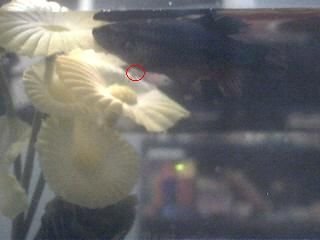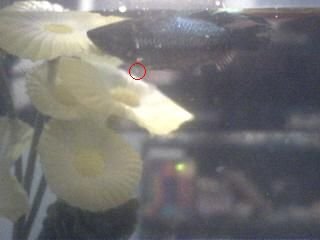You are using an out of date browser. It may not display this or other websites correctly.
You should upgrade or use an alternative browser.
You should upgrade or use an alternative browser.
HELP!!!
- Thread starter fourplayfishy
- Start date
fourplayfishy
Fishaholic
Texaswoman
Fish Crazy
I don't know. I still can't see anything clearly. Give us some more details about diet, tank, how long youv'e had the fish. etc.
fourplayfishy
Fishaholic
no point she died thismorning :9 
 RIP Osiris
RIP Osiris

 RIP Osiris
RIP OsirisNuttygal! :0)
Fishaholic
 Osiris
Osiris 
 Sorry for your loss. Could it have been a paracite? If youhave any other fish in that tank have they been affected?
Sorry for your loss. Could it have been a paracite? If youhave any other fish in that tank have they been affected?Texaswoman
Fish Crazy
Sorry, wish we could of helped you sooner. 

tekknocolor
Fish Herder
SRC
Some days even my lucky rocketship underpants won'
awwww sorry about your fish 
maybe this is what happened?
maybe this is what happened?
Monogenean Parasites of Fish 1
Peggy Reed, Ruth Francis-Floyd, and RuthEllen Klinger2
Introduction
Monogeneans (flukes) are a group of parasites best described as flatworms. Monogeneans are commonly found on the gills, skin or fins of fishes and lower aquatic invertebrates. A few may invade the rectal cavity, ureter, body cavity and even the blood vascular system. There are more than 100 families of monogeneans found on fishes of the world, in fresh and salt water, and at a variety of temperatures.
Most monogeneans are browsers, moving about the body surface and feeding on dermal (skin) mucus and gill debris. Monogeneans have a series of hooks that enable them to attach while feeding ( Figure 1 ). Most species are host- and site-specific, requiring only one host to complete an entire life cycle. In fact, some adult monogeneans will remain permanently attached to a single site on the host.
Morbidity and mortality epidemics in cultured fish caused by excessive parasite loads are associated with crowding, inadequate sanitation and deterioration of water quality. Although monogeneans are commonly found on wild fish, they are rarely a direct cause of disease or death in free-ranging populations.
Dactylogyrus is usually attached to the gills of freshwater fish. It reproduces by laying eggs, which are often resistant to chemical treatment, therefore weekly treatment over a period of 34 weeks is recommended.
Gyrodactylus is usually found on the skin and fins of freshwater fish and produces live young, so one treatment may be adequate to control an infestation.
Benedeniella is a large monogene that can cause chronic problems in marine systems and is difficult to eliminate from a system once established.
Clinical Signs and Effects
Freshwater fish infested with skin-inhabiting flukes become lethargic, swim near the surface, seek the sides of the pond and their appetite dwindles. They may be seen rubbing the bottom or sides of the holding facility (flashing). The skin, where the flukes are attached, shows areas of scale loss and may ooze a pinkish serous fluid. Heavy gill infestations ( Figure 2 ) result in respiratory disease. Gills may be swollen and pale, respiration rate may be increased, and fish will be less tolerant of low oxygen conditions. "Piping," gulping air at the water surface, may be observed in fish with severe respiratory distress. Large numbers of monogeneans on either the skin or gills may result in significant damage and mortality. Secondary infection by bacteria and fungus is common on tissue that has been damaged by monogeneans.
In salt water fish, sharks, skates and rays, the monogenean, Neobenedinia spp., may infest the skin and gills, resulting in extreme irritation to the host. Sharks with heavy infestations swim erratically, and exhibit behaviour such as flashing and rubbing on the bottom of the tank. Gray patches and open wounds may appear on the skin. Ulcerated skin lesions are susceptible to secondary bacterial infections, which may result in mortality. Affected gills may become irritated, hemorrhaged and swollen. Sand grains may stick to the gills as infested sharks suck in sand in an attempt to rub off the parasites.
Transmission
Transmission of monogenean flukes from fish to fish is primarily by direct contact. Monogeneans tend to have direct life cycles, which means that no intermediate host is required for the parasite to reproduce ( Figure 3 ). Adults are hermaphroditic, which means that each organism has both male and female reproductive structures. Oviparous monogenes (i.e., Dactylogyridae) release eggs into the water column that hatch and mature prior to seeking a new host. Viviparous monogenes (i.e., Gyrodactylidae) release live larvae that are immediately able to attach to the same host as the parent or be carried by the water to another host. The direct life cycle can contribute to population explosions in aquaculture systems, resulting in clinical disease.
There are two common genera of freshwater flukes, Gyrodactylus and Dactylogyrus, which differ markedly in their reproductive strategies as well as their preferred attachment sites on host fish. Gyrodactylus are viviparous (produce live young), and are generally found on the body and fins of fish. Each individual parasite has both male and female reproductive organs. Adult parasites carry fully developed embryos (identical to the adult) which in turn, carry young of the next generation. Therefore, each individual parasite may represent several generations. This reproductive strategy allows populations of Gyrodactylus to multiply very quickly, particularly in a closed system where water exchange is minimal.
Members of the genus Dactylogyrus prefer to attach to gills of host fish. Unlike Gyrodactylus, parasites in the genus Dactylogyrus are egg layers. The eggs can be resilient to chemical treatment, therefore multiple treatments (1 dose per week) are appropriate to control this group of organisms. When the free-swimming ciliated larvae emerge from the eggs they are carried to a new host by water currents as well as by their own movement. The time required for maturation of Dactylogyrus from eggs to adult is temperature dependent. At water temperatures of 72-75°F only a few days are required for completion of the life cycle, whereas at water temperatures of 34-36°F generation time is extended to five or six months.
Management
The best way to manage monogeneans is to avoid introducing parasites to a new system. This can be done by by following a quarantine protocol whenever feasible. If quarantine is not possible, a simple way to minimize the introduction of monogeneans, as well as other external parasites, is to dip fish in fresh or salt water, depending on the fish species. Salt water fish can be dipped in freshwater which will eliminate many single-celled external parasites, and freshwater fish can be dipped in sea water to accomplish the same goal. This practice will not completely eliminate the risk of introducing parasites to an established tank or system, but will help minimize the numbers brought in.
Ideally, fish should be quarantined for at least three weeks prior to being placed into a new system. While in quarantine, gill and skin biopsies can be performed to determine whether monogeneans, or other gill or skin pathogens are present. Any parasites identified using biopsy techniques can then be specifically treated and eliminated. If biopsies cannot be done, prophylactic treatment with a broad spectrum parasiticide, such as formalin or potassium permanganate, should be carried out. A quarantine system should be very simple so that fish are readily accessible for observation and handling, water can be easily changed, and treatments readily administered.
Treatment of monogeneans is usually not satisfactory unless the primary cause of increased fluke populations is found and alleviated. The treatment of choice for freshwater fishes is formalin, administered as a prolonged bath at 25 mg/L or a short-term bath at 150-250 mg/L for 30 minutes. Sick fish do not tolerate formalin well and all fish should be carefully watched during chemical administration (see UF/IFAS Extension Fact Sheet VM-77 Use of Formalin to Control Fish Parasites). If adverse reaction is observed, fish should be removed from the treatment tank at once and placed in clean water.
Potassium permanganate is also effective against monogeneans, and is the treatment of choice if columnaris bacteria or fungi are invading damaged tissues. Potassium permanganate can be administered as a prolonged bath at a concentration of 2 mg/L or as a short-term bath (30 minutes) at a concentration of 10 mg/L. Again, fish must be observed carefully while they are in contact with the chemical and they should be removed at once if adverse effects are noticed. For further information see UF/IFAS Extension Fact Sheets FA-23 The Use of Potassium Permanganate in Fish Ponds and FA-37 Use of Potassium Permanganate to Control External Infections of Ornamental Fish.
Freshwater dips should be given to saltwater fish prior to placing them into a new system. This is very helpful in preventing the initial introduction of monogeneans. Once monogeneans are established in a system, complete elimination is difficult. However, copper treatments applied at 0.2 mg/L active copper ion for up to three weeks are helpful in controlling certain flukes, such as Neobenedinia. Certain marine fish, particularly sharks and rays, do not tolerate copper well, and it is lethal to invertebrates.
Summary
Monogeneans are found on fresh and salt water fishes throughout the world. They have a direct life cycle and can reproduce in a wide range of temperatures. Monogeneans have a series of hooks that attach to the fish causing irritation, excessive mucus production, and which create an open window for bacterial invasion. A few flukes on a healthy mature fish are not usually significant, however, moderate numbers on a young fish can cause significant mortalities. When fish are crowded or sanitation practices are poor, the potential damage from monogeneans is greater. Prevention of monogenean infestations by following appropriate quarantine practices is preferable to treating the parasites after they have become established in a system. Formalin and potassium permanganate baths are effective for controlling monogenean infestations in freshwater fish, and copper is often used to control infestations of marine fish.
http/edis.ifas.ufl.edu/FA033
Whiskerz
Fish Herder
I'm sorry to hear your fish didn't make it fourplayfishy 
 Osiris
Osiris

 Osiris
OsirisSimilar threads
- Replies
- 5
- Views
- 436
Most reactions
-
 355
355 -
 154
154 -
 143
143 -
 141
141 -
 141
141 -
 140
140 -
 122
122 -
 114
114 -
 73
73 -
 73
73 -
 69
69 -
 57
57 -
 49
49 -
F
44
-
 41
41


